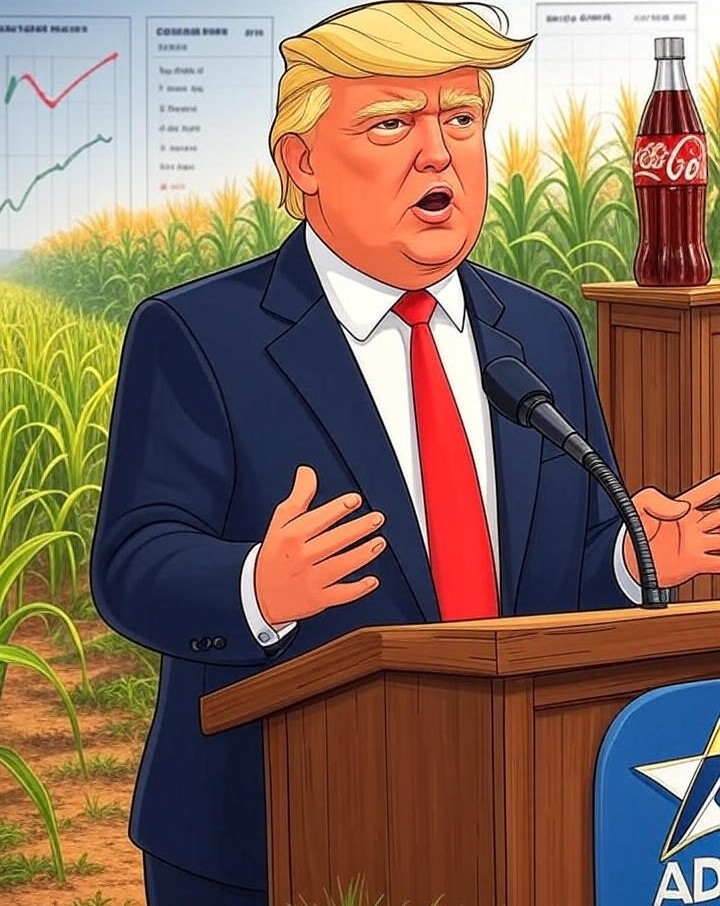Tariff changes, political posturing, and consumer preference shifts are in flux—and companies like Coca-Cola (KO) and Archer Daniels Midland (ADM) are examples of how one little change has a ripple effect all the way down to the consumer. You may not know, but the United States has some of the most restrictive sugar import rules in the world.
Current Sugar Tariffs
The U.S. sugar market is protected by a tariff-rate quota (TRQ) system. Each year, the U.S. sets a quota—about 1.12 million metric tons of raw cane sugar for FY 2025—mostly allocated to WTO partner nations. Sugar imports within that quota face a low tariff. Anything above that gets hit with prohibitively high tariffs, sometimes over $0.15 per pound. This effectively shuts out low-cost global supply.
The USDA also enforces price supports through loans and marketing allotments to keep domestic prices high. This system favors U.S. sugar producers, restricts supply, and drives up prices across the board (ERS).
In March 2024, the USDA increased the quota slightly by 125,000 tons to ease supply constraints (Baking Business). But it was a performative change and did little to the price of sugar.
New Tariff Proposals
President Donald Trump has floated a 10% across-the-board tariff surcharge on imports from trade-surplus countries. If applied to sugar within the TRQ, it would raise prices even more for buyers like Coca-Cola. Brazil—one of the largest global sugar exporters—is already hit with out-of-quota tariffs of around $360/ton and is lobbying for relief (Reuters).
If these new tariffs hit sugar or sugar-containing products, the effects will ripple through multiple industries.
Trump, Coke, and Sugar
Trump recently claimed he convinced Coca-Cola to return to using cane sugar in the U.S. instead of high-fructose corn syrup (HFCS), which it currently uses in almost all domestic bottling (Time).
Whether the switch is real or bluster remains to be seen. Coca-Cola hasn’t confirmed a full transition but said it’s reviewing “sourcing strategies.” Even a partial shift could significantly affect U.S. commodity demand.
What This Means for ADM
ADM is one of the largest producers of HFCS, which is derived from U.S. corn. The vast majority of soft drinks and processed foods in America rely on HFCS because it’s cheaper than imported cane sugar under current tariff rules.
If Coca-Cola moves away from HFCS, even in part, ADM loses. Investors know this. When Trump’s cane sugar comment made headlines, ADM stock dropped by 2–5% (Investopedia).
ADM is already under pressure. Its Q1 2025 earnings disappointed, with ag services and nutrition taking hits (Reuters). A hit to its HFCS business would further strain revenue and potentially put pressure on dividends.
Long-term, a shift away from HFCS threatens a core pillar of ADM’s business. U.S. corn farmers—who supply the raw material for HFCS—would also feel the pain. One estimate suggests they could lose up to $5 billion annually if soft drink makers pivot toward cane sugar (Reuters).
What This Means for Coca-Cola
KO’s stock rose slightly after the Trump announcement, likely on the idea that the brand could gain goodwill by going “natural” with real sugar.
But costs are going up. Cane sugar is 10–15% more expensive than HFCS—and possibly more if new tariffs apply to imports under the TRQ or beyond it (CZ).
Coca-Cola has pricing power. The company has proven it can raise prices without significantly denting demand. That’s how it managed through recent inflation cycles. So if costs go up, KO can pass some of that along to consumers (Morningstar).
The bigger risk is to margins. KO’s dividend is safe for now—it’s a priority for the company—but profit growth may slow if costs stay elevated and price hikes hit resistance.
What This Means for Consumers
If Coca-Cola switches to cane sugar, expect to pay more at the register. Mexican Coke, which already uses cane sugar, typically costs more than the standard HFCS version. A nationwide shift would likely mean a 10–15% bump in prices.
And if tariffs drive up input costs across the board, it won’t stop at soda. Candy, cereal, baked goods—anything with sugar—will be affected.
Expect a wide ripple effect
- Sugar tariffs are already high, and new proposals may raise them further.
- ADM loses if HFCS demand falls. KO can manage costs—up to a point.
- Consumers will pay more for cane sugar Coke, and possibly for everything else sweetened.
Unless sugar policy is overhauled, U.S. companies and consumers will continue to carry the cost of protecting a few domestic producers. For ADM, this is a direct threat. For KO, it’s a challenge they’re probably equipped to handle—unless tariffs go much higher.

